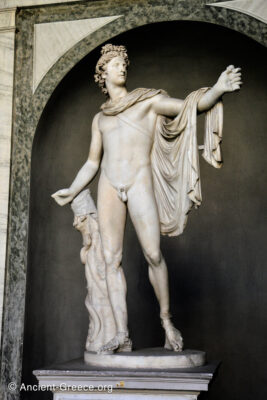Original bronze is attributed to the Greek sculptor Leochares. Also known as Belvedere Apollo, Apollo of the Belvedere, or Pythian Apollo.
Exhibited at the Vatican Museums, Italy.
[Apollo Belvedere]was purchased by Pope Julius II., who removed it to the Belvedere of the Vatican, from whence it takes its name, and where it has been, for more than three hundred years, the admiration of the world. When Rome was taken, and plundered by the French, this celebrated statue was transported to Paris, and placed in the museum there, but in 1815 it was restored to its former place in the Vatican.
The attitude of the figure, which is more than seven feet high, is inimitable in its freedom, grace, and majesty. The forehead is noble and intellectual, and the whole countenance so exquisite in its beauty, that one pauses spell-bound to gaze on so perfect a conception. The god has a very youthful appearance, as is usual in all his representations, and with the exception of a short mantle which falls from his shoulders, is unclothed. He stands against the trunk of a tree, up which a serpent is creeping, and his left arm is outstretched, as though about to punish.
From: Berens, E.M. The Myths and Legends of Ancient Greece and Rome. New York: Maynard, Merril, & Co., 1880. Text in the public domain.


